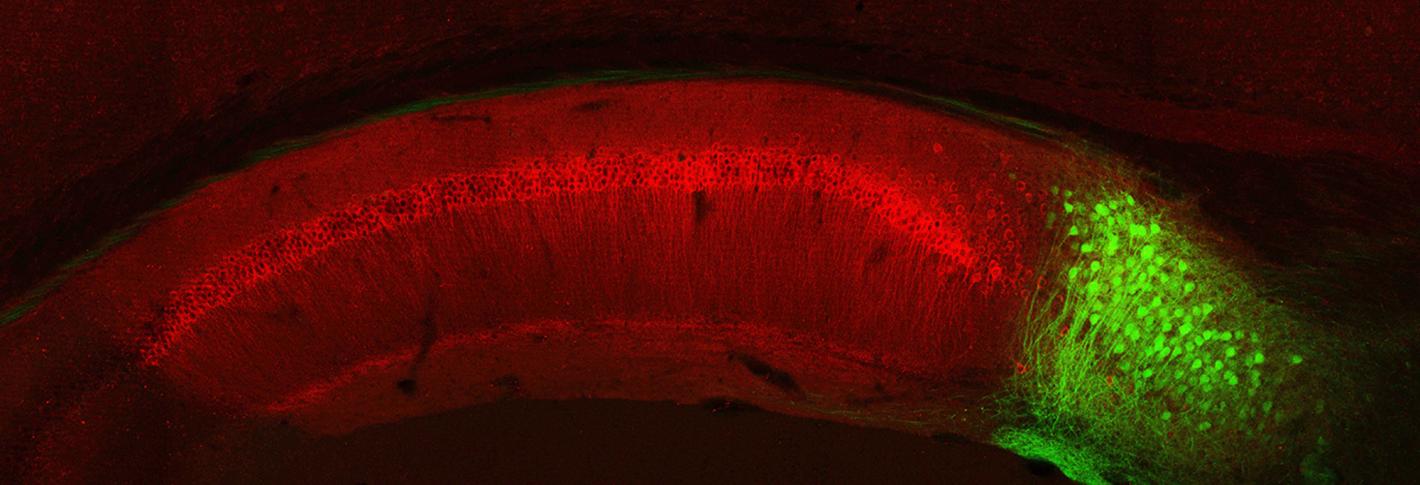Parts unknown
The hippocampus is divided into several regions with different memory-related functions — most of which have been well-explored, but a small area called the subiculum has been little-studied. Tonegawa’s lab set out to investigate this region using mice that were genetically engineered so that their subiculum neurons could be turned on or off using light.
The researchers used this approach to control memory cells during a fear-conditioning event — that is, a mild electric shock delivered when the mouse is in a particular chamber.
Previous research has shown that encoding these memories involves cells in a part of the hippocampus called CA1, which then relays information to another brain structure called the entorhinal cortex. In each location, small subsets of neurons are activated, forming memory traces known as engrams.
“It’s been thought that the circuits which are involved in forming engrams are the same as the circuits involved in the re-activation of these cells that occurs during the recall process,” Tonegawa says.
However, scientists had previously identified anatomical connections that detour from CA1 through the subiculum, which then connects to the entorhinal cortex. The function of this circuit, and of the subiculum in general, was unknown.
In one group of mice, the MIT team inhibited neurons of the subiculum as the mice underwent fear conditioning, which had no effect on their ability to later recall the experience. However, in another group, they inhibited subiculum neurons after fear conditioning had occurred, when the mice were placed back in the original chamber. These mice did not show the usual fear response, demonstrating that their ability to recall the memory was impaired.
This provides evidence that the detour circuit involving the subiculum is necessary for memory recall but not for memory formation. Other experiments revealed that the direct circuit from CA1 to the entorhinal cortex is not necessary for memory recall, but is required for memory formation.
“Initially, we did not expect the outcome would come out this way,” Tonegawa says. “We just planned to explore what the function of the subiculum could be.”
“This paper is a tour de force of advanced neuroscience techniques, with an intriguing core result showing the existence and importance of different pathways for formation and retrieval of hippocampus-dependent memories,” says Karl Deisseroth, a professor of bioengineering and psychiatry and behavioral sciences at Stanford University, who was not involved in the study.
Editing memories
Why would the hippocampus need two distinct circuits for memory formation and recall? The researchers found evidence for two possible explanations. One is that interactions of the two circuits make it easier to edit or update memories. As the recall circuit is activated, simultaneous activation of the memory formation circuit allows new information to be added.
“We think that having these circuits in parallel helps the animal first recall the memory, and when needed, encode new information,” Roy says. “It’s very common when you remember a previous experience, if there’s something new to add, to incorporate the new information into the existing memory.”
Another possible function of the detour circuit is to help stimulate longer-term stress responses. The researchers found that the subiculum connects to a pair of structures in the hypothalamus known as the mammillary bodies, which stimulates the release of stress hormones called corticosteroids. That takes place at least an hour after the fearful memory is recalled.
While the researchers identified the two-circuit system in experiments involving memories with an emotional component (both positive and negative), the system is likely involved in any kind of episodic memory, the researchers say.
The findings also suggest an intriguing possibility related to Alzheimer’s disease, according to the researchers. Last year, Roy and others in Tonegawa’s lab found that mice with a version of early-stage Alzheimer’s disease have trouble recalling memories but are still able to form new memories. The new study suggests that this subiculum circuit may be affected in Alzheimer’s disease, although the researchers have not studied this.
The research was funded by the RIKEN Brain Science Institute, the Howard Hughes Medical Institute, and the JPB Foundation.
MIT News >>






